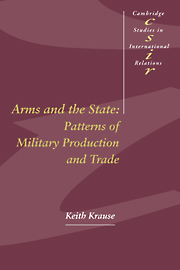Book contents
- Frontmatter
- Contents
- List of figures
- List of tables
- Acknowledgements
- Introduction
- 1 Motive forces in the evolution of the arms transfer and production system
- 2 The emergence of a global arms transfer and production system
- 3 From the Military Revolution to the Industrial Revolution
- 4 An overview of the post-1945 global arms transfer system
- 5 The dominance of first-tier producers and suppliers
- 6 Second-tier producers and suppliers: the struggle to keep pace
- 7 Dependent production and exports in the third tier
- 8 The subordinate role of arms recipients
- Conclusion
- Appendix: Arms transfer data sources and problems
- Notes
- Bibliography
- Index
Appendix: Arms transfer data sources and problems
Published online by Cambridge University Press: 22 September 2009
- Frontmatter
- Contents
- List of figures
- List of tables
- Acknowledgements
- Introduction
- 1 Motive forces in the evolution of the arms transfer and production system
- 2 The emergence of a global arms transfer and production system
- 3 From the Military Revolution to the Industrial Revolution
- 4 An overview of the post-1945 global arms transfer system
- 5 The dominance of first-tier producers and suppliers
- 6 Second-tier producers and suppliers: the struggle to keep pace
- 7 Dependent production and exports in the third tier
- 8 The subordinate role of arms recipients
- Conclusion
- Appendix: Arms transfer data sources and problems
- Notes
- Bibliography
- Index
Summary
Any publication using arms transfer data ought to acknowledge the severe, and possibly crippling, shortcomings of such data. Several specific and general problems can be highlighted which make conclusions based on statistical manipulation of the data extremely tentative. This appendix merely sketches the problems; readers are encouraged to consult the more detailed studies noted throughout.
There are four main sources of arms transfer information: The United States Arms Control and Disarmament Agency (ACDA) annual publication World Military Expenditures and Arms Transfers; the Stockholm International Peace Research Institute Yearbook of World Armaments and Disarmament (and related publications using the same data base); the International Institute of Strategic Studies (IISS) annual The Military Balance; and other (usually country-specific) studies. The ACDA data have been relied upon most in this book, because they possess three advantages other sources do not: they include all suppliers and recipients, they attempt to capture all transfers (not just major weapons systems), and they present at least roughly comparable dollar figures for arms deliveries. SIPRI data, on the other hand, include only deliveries of major weapons systems (aircraft, armour and artillery, guidance and radar systems, missiles and warships), and they also detail major identified arms agreements in their comprehensive data base of arms transfers since 1950.
- Type
- Chapter
- Information
- Arms and the StatePatterns of Military Production and Trade, pp. 216 - 219Publisher: Cambridge University PressPrint publication year: 1992

